File Output - Arnold for Houdini
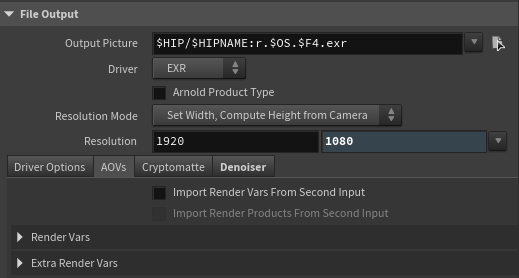
Output Picture The name and location of the render output. If you are not using the Arnold product type, the extension in the file name determines the output format.
You can use the standard Houdini variables and expressions in the file name.
If you use the Arnold product type, the output folders must already exist. Arnold does not create folders.
Driver Selects the Arnold driver used by kick and sick (Direct USD Render) If you enable the Arnold Product Type, then Husk uses this driver too, both for the scene view and renders to disk.
Arnold Product Type Enable this to make Husk use the Arnold drivers. The Arnold product type is required for driver options such as multipart and autocrop.
Driver Options
If you use the Arnold product type, then you can use the Arnold driver options:
AOVs
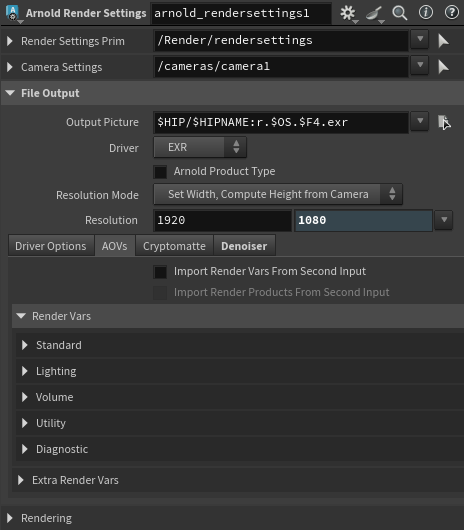
Users can select the AOVs they want to render. Source is the source for the AOV (an Arnold channel). The Optional AOV name will be the name of the AOV in the file. This is the same name as the Source, by default.
Import Render Vars from Second Input Finds RenderVar prims in this node's second input and adds them to this stage, so they add to the list of render vars to generate. This allows other LOP nodes (such as Background Plate) to offer render vars related to that node to be generated.
Import Render Products from Second Input Finds RenderProduct prims in this node's second input and adds them to this stage, so they add to the list of products to generate. This allows other LOP nodes to offer products related to that node to be generated.
Example: Cryptomatte AOVs in a separate render product
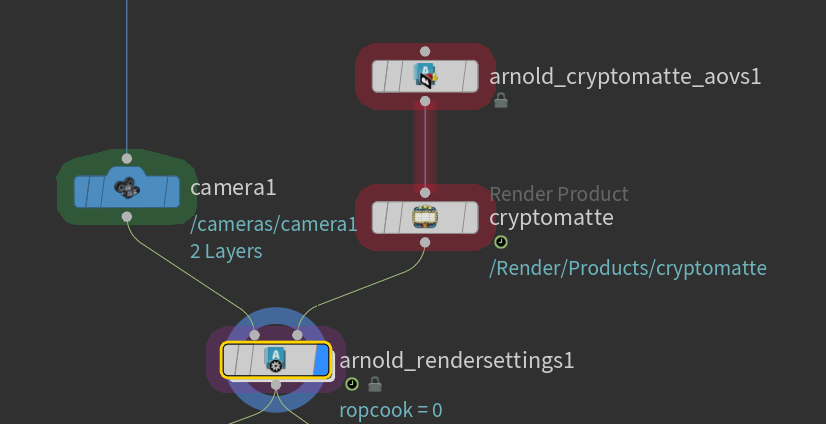
Render Vars
Built-in default render vars include the following:
Standard: Alpha, point position, normal, opacity, z-depth.
Lighting: Direct lighting, indirect lighting, emission, etc.
Volume: Z-depth, Albedo, direct lighting, indirect lighting, opacity.
Utility: ID, object, shader, motion vector.
Diagnostic: CPU time, ray count, aa inv density.
Extra Render Vars
Use this multiparm to create extra render vars, such as light group AOVs or custom AOVs.
Name
The name of the AOV in the output image that stores the data from this rendervar.
Format
The data format that should be used when saving this image plane to the output file.
Data Type
The USD data type of the render variable.
When saving to OpenEXR files, the data type is used to determine the channel names. For example, if the data type is color3f, the channel names will be R, G, B, while if the data type is normal3f, the channel names will be x, y, z.
Source Name
Where to get the render variable contents. See Source type below.
The renderer should look for an output with this name as the computed value for the RenderVar.
Source Type
How to interpret the Source name parameter.
Raw Pass the source name directly to the renderer.
Primvar The Source name is the name of primvar.
LPE The Source name is a Light Path Expression.
Filter
The filter type used for averaging individual subpixel samples into a final pixel color.
Cryptomatte
Selecting Use Cryptomatte automatically adds the Cryptomatte shader. You can find the Cryptomatte shader in the Scene Graph if you need to edit it.
To render cryptomattes with husk, you need to use the Arnold product type.
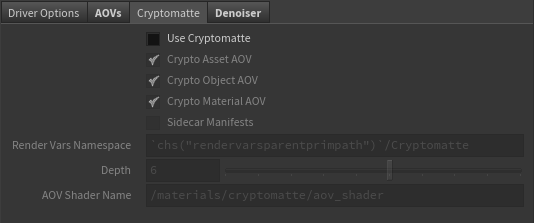
More information about cryptomatte can be found here. More information about cryptomatte AOVs can be found here.
Denoiser
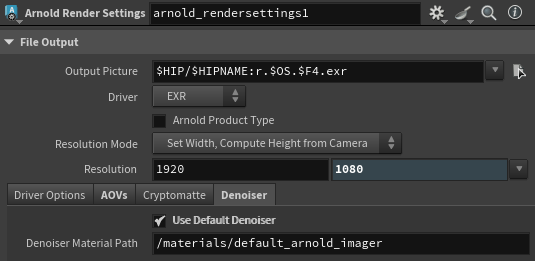
By default, the Intel® Open Image Denoiser imager (OIDN) is automatically added to new scenes (existing ROPs are unchanged). You can disable the default denoiser by setting the ARNOLD_DEFAULT_DENOISER environment variable (to false, off, or 0).
